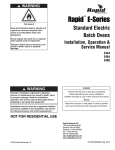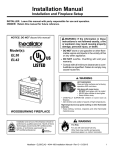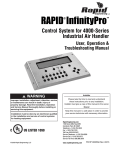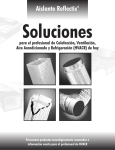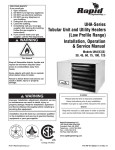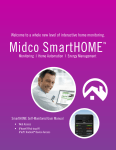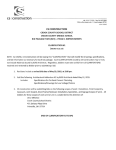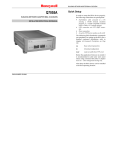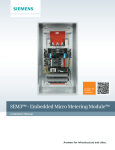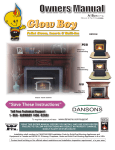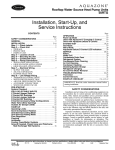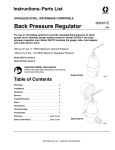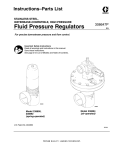Download Equipment Specifications - Rapid Engineering LLC HVAC Products
Transcript
4000-Series
Equipment Specifications
1.800.536.3461
CANADA: 100% OUTSIDE AIR ONLY
SECTION 15624: DIRECT FIRED AIR HANDLER GUIDE SPECIFICATION
PART 1 GENERAL
Provide units with gas-fired heating and ventilating sections, designed
and manufactured for indoor or outdoor installation. Units shall be
packaged air handlers which include casing, modulating burner, nonoverloading fan, mixing chamber (AM and VAV Models only), positive
position modulating return air dampers (AM and VAV Models only),
and automated DDC-based controls for temperature control, pressure
control and system monitoring.
1.1 SECTION INCLUDES
A. Direct-fired air handler
B. Controls
H. National Roofing Contractors Association (NRCA):
1. The NRCA Roofing and Waterproofing Manual, Second Edition
I. Occupational Safety and Health Administration (OSHA):
(Enforces air quality standards and safety in the workplace.)
J. Underwriters Laboratories, Inc. (UL):
(Nationally recognized testing laboratory certifies code conformance,
product labeling and listing.)
1. Standard UL916 Energy Management Equipment
2. Standard UL873 Temperature Indicating & Regulating
Equipment
1.4SUBMITTALS FOR REVIEW
1.2RELATED SECTIONS
A. Section 01300 - Submittals: Procedures for submittals
A. Section 15410 - Plumbing Piping: [Natural] [Propane] gas piping
and connections
B. Product Data: Provide data with dimensions, duct and service
connections, accessories, controls, electrical nameplate data and
wiring diagrams.
B. Section 15860 - Centrifugal Fans: Supply Fans
C. Section 15885 - Air Cleaning Devices: Filters
D. Section 15990 - Testing, Adjustment and Balancing
C. Shop Drawings: Indicate dimensions, duct and service connections,
accessories, controls, electrical nameplate data and wiring diagrams.
E. Section 15020 - Mechanical Special Conditions
1.5SUBMITTALS FOR INFORMATION
F. Section 16180 - Basic Electrical Materials and Methods
A. Section 01300 - Submittals: Procedures for submittals
1.3 REFERENCES
B. Manufacturer’s Instructions: Indicate rigging, assembly and
installation instructions.
A. American National Standards Institute (ANSI):
(Establishes requirements applicable to certifying direct gas-fired
heaters.)
1. MUA Model: Standard Z83.4;
Non-Recirculating Direct Gas-Fired Industrial Air Heaters
2. AM, VAV, AR Models: Standard Z83.18;
Recirculating Direct Gas-Fired Industrial Air Heaters
B. American Society for Testing Materials (ASTM):
1. Standard A653/653M; Standard Specification for Steel
Sheet, Zinc-Coated (Galvanized) or Zinc-Iron Alloy-Coated
(Galvannealed) by the Hot Dip Process
C. ETL Testing Laboratories, Inc. (ETL):
(Nationally recognized testing laboratory certifies code conformance.)
1. Requirements applicable to product labeling and listing in the
Directory of ETL Listed Products.
D. Factory Mutual Insurance (FM):
(Certifies gas manifold to owner's insurance carrier.)
E. Industrial Risk Insurance (IRI):
(Certifies gas manifold to owner's insurance carrier.)
F. National Electrical Manufacturers Association (NEMA):
1. Standard 250; Enclosures for Electrical Equipment
(1000 V Maximum)
G. National Fire Protection Association (NFPA):
(Establishes fire prevention standards.)
1. Article 54; National Fuel Gas Code
2. Article 70; National Electric Code
3. Article 90A; Installation of Air Conditioning and Ventilating Systems
2
1.6SUBMITTALS AT PROJECT CLOSEOUT
A. Section 01700 - Contract Closeout
B. Project Record Documents: Record actual locations of remote
sensors, control panels and other components.
C. Operation and Maintenance Data: Include manufacturer’s
operating instructions, installation instructions, maintenance data,
and parts listing.
D. Warranty: Submit manufacturer’s warranty and ensure forms
have been filled out in owner’s name and registered with the
manufacturer.
1.7 QUALITY ASSURANCE
A. Manufacturer Qualifications: Company specializing in
manufacturing the products specified in this section (proportional,
building pressure controlling, modulating direct-fired air handler/
air turnover unit) with a minimum of ten years documented
experience. Equipment shall be the standard product of the
manufacturer and shall have complete cataloged data.
B. Installer Qualifications: All installation and service of direct fired
air handlers must be performed by a contractor qualified in the
installation and service of said products with proof of a minimum
of three years documented experience.
C. Factory Testing: Each air handler shall be factory-tested. Testing
shall consist of checking all circuits for continuity, operability
of all valves, control motors, fan speed, linkages, switches and
burner. Each air handler shall be test-fired for minimum and high
fire conditions. See "Fan and Motor" for additional fan testing
requirements.
SECTION 15624: DIRECT FIRED AIR HANDLER GUIDE SPECIFICATION
1.8 REGULATORY REQUIREMENTS
A. Conform to ANSI Standards Z83.18 or Z83.4 (latest revision) and
provide evidence that the air handler and its control system have
been found in compliance as a system with these standards by a
nationally recognized testing laboratory.
B. Conform to NFPA 90A.
C. Conform to the National Fuel Gas Code (NFPA 54 / ANSI Z223.1).
D. Conform to required or specified insurance specifications (FM,
IRI, etc.) for the gas manifold construction.
1.9 WARRANTY
A. Limited warranty of twenty-four (24) months from the date of
purchase by Buyer or twenty-seven (27) months from date of
shipment by Seller, whichever occurs first. For all deliverables
(other than replacement parts) that require installation and startup, the otherwise applicable warranty period shall be extended by
an additional four (4) months if (1) the installation and start-up
is performed by a contractor on Seller's current list of contractors
who have successfully completed Seller's current installation course
for that deliverable and (2) full details of the installation and startup are provided to Seller at or prior to the time any warranty claim
is made.
1.10 MAINTENANCE SERVICE
A. Section 01700 - Contract Closeout
B. Provide service and maintenance for each air handler for one year
from Date of Substantial Completion.
1.11 EXTRA MATERIALS
A. Section 01700 - Contract Closeout
B. Section 01730 - Operation and Maintenance Data
PART 2 PRODUCTS
2.1 MANUFACTURERS
A. Rapid Engineering's Series 4000, incorporating one of the
following outdoor air control schemes, as specified herein or
shown on the plans:
• 20% - 100% outdoor air (4000 AM)
• 100% outdoor air (4000 MUA or 4000 VSD)
• 20% outdoor air (4000 FR)
• 20% - 100% variable air volume (4000 VAV)
B. Section 01600 - Materials and Equipment: Product Options
2.2 MANUFACTURED UNITS
A. Unit: [Constant] [variable] volume [outdoor] [indoor] direct-fired
air handler.
2.3 FABRICATION
A. Casing and Components: Heavy gauge aluminized steel enclosure,
arc welded to a steel angle frame. The panels for outdoor units
shall be stitch welded and caulked at the seams to provide a
watertight enclosure.
B. Fan Support: The fan and bearings shall be supported by a
reinforced steel framework independent of the cabinet.
C. Access Doors: Neoprene-gasketed doors shall be provided to allow
easy service of all critical components, controls and fan.
D. Outdoor Installation: Units installed outdoors shall utilize
weatherproof construction with intake hood or plenum.
E. Lifting Points: Internal members shall be properly sized to allow
rigging and handling of the unit from the top.
F. Finish: All cabinet surfaces inside and out shall be cleaned of
oil and grease, treated with a rust-inhibiting, iron phosphate
surface coating and then followed by a passivating rinse. After the
passivating rinse, cabinets shall be baked to ensure all moisture
is removed from metal joints before prime coating. All exterior
surfaces of the cabinet and any uncoated steel surfaces within shall
be painted with a high quality prime and finish coat of waterbase,
rust-inhibiting, machinery grade enamel.
G. Observation Port: Provide on burner section for observing main
and pilot flames.
H. Mixing Section (Optional): The air handler shall incorporate
a separate compartment containing two 16-gauge galvanized
dampers interlinked to work opposite each other. Each damper
shall control up to 80% of the total air handler fan volume of either
outdoor air or the return air from the building. These dampers
shall be controlled so as to provide an outdoor air turndown ratio
of 5:1 based on the fan total flow rate.
2.4BURNER AND GAS TRAIN
A. Burner: Type NP-LE as manufactured by Maxon Burner Company
or type HMA-2 by Midco, specially designed to burn natural or
propane gas at or below the non-contaminating levels required by
ANSI and OSHA. The burner shall have an aluminum manifold
and heat resistant Type 430 stainless steel burner plates. The
burner shall have a nominal 30:1 turndown ratio and be designed
for 100% combustion efficiency for the life of the equipment.
B. Burner Profile: The outdoor air velocity across the burner on
all constant volume designs shall be controlled by fixed burner
profile plates. The design of the unit profile plates shall maintain
manufacturer’s specified air velocity at all times over the burner
during operation. No air from the occupied space shall be allowed
to recirculate across the burner at any time.
C. Burner Assembly / Gas Train: The burner assembly and fuel piping
arrangement shall include automatic ignition controls, UV scanner
flame failure system, 5 psig pressure regulator, fully modulating
gas control valve, primary and secondary automatic shutoff valves
and manual shutoff valve. Pilot gas controls shall include a pilot
regulator, normally-closed solenoid shutoff valve, needle valve,
high gas pressure switch and manual shutoff valve. Gas train shall
be sized to provide full unit capacity at specified inlet pressure
to the gas train. Provide and install a supplementary pressure
regulator at each unit as necessary to maintain unit inlet pressure
at less than 5 psig.
D. Pilot: Electric spark ignition through a high voltage ignition
transformer or hot surface ignition.
E. Damper (optional on FR and MUA style air handlers):
Motorized with end switch to prove position before burner will
fire.
3
SECTION 15624: DIRECT FIRED AIR HANDLER GUIDE SPECIFICATION
2.5 FAN AND MOTOR
A. Fan: Single width, single inlet, efficient silent plenum, and belt
driven for the specified air capacity. A precision inlet cone shall
be provided for streamlined airflow into the fan wheel to insure
full and even loading of the fan blades. Blower wheel, shaft and
drive sheaves shall be both statically and dynamically balanced.
Each fan and drive combination shall be dynamically balanced
during testing at the factory to .1" per second or less equivalent
displacement.
1. High Gas Pressure: The high gas pressure switch, located on the
burner end of the manifold, shall turn the burner off when the
gas pressure is above its setpoint. The maximum gas pressure
shall be selectable between 3" w.c. and 21" w.c.
2. Low Gas Pressure: The low gas pressure switch, located on the
inlet end of the manifold, shall turn the burner off when the gas
pressure is below its setpoint. The minimum gas pressure shall
be set at 3" w.c.
3. Air Flow: The air flow switches measure air pressure differential
across the burner to assure proper air flow during burner
operation and prior to ignition. It shall be factory set at 0.2" w.c.
for the low setting and 1.35" w.c. for the high setting.
4. High Temperature Limit: A manual reset high temperature
switch shall turn the burner off when air is discharged above its
set point. The High Temperature Limit Switch shall be factory
set at 150°F.
B. Drive: The fan shaft shall be connected to the motor by a multiple
V-belt drive designed to handle 50% more power than the
motor name plate capacity. The fan wheel and bearings shall be
supported by reinforced structural steel framework independent
of the unit housing. The motor sheave shall be a fixed design for
motors larger than 7.5 HP.
C. Fan Bearings: Self-aligning, pillow block or flange type and shall
have (for external static pressure less than 1" w.c.) an ABMA L10
rated life of 100,000 hours and be equipped with optional extended
lubrication lines. Extended lubrication lines shall be terminated
at the unit’s outer skin so that all lubrication can be performed
without shutting down the system.
E. Sequence of Operation (All control types)
With the main fused disconnect in the "ON" position:
The Time Clock settings determine whether the air handler
operates in the Occupied or Unoccupied Modes. (Time clock is
software-based for DDC controls.)
D. Motor: The motor shall be an [open drip proof] [TEFC] [premium
efficiency] design with minimum service factor of 1.15, wired
for the selected voltage, 1750 rpm, standard NEMA frame and
mounted on an adjustable slide base.
COOLING / SUMMER SEQUENCE (Occupied Mode):
G. Exhaust Mode (Optional): Incorporate controls and additional
dampers in the fan section for discharge and exhaust functions.
1. Discharge Damper: 16 gauge, galvanized steel with frame
supporting damper blades to prevent twisting and flexing;
friction free bearings; operator located outside of air stream.
2. Exhaust Air Damper: Maximum leakage of 5 cfm per sq. ft. of damper at 4" w.c. Air velocity through exhaust damper
is not to exceed 2000 fpm.
• The burner is off completely whenever the room temperature
exceeds the [Cooling] [Outdoor Air Stat] Setpoint.
• The damper control operates the dampers as follows
(AM & VAV units only):
a) The "MANUAL" mode allows manual positioning of the 80%
outside air (OA) damper and 80% return air (RA) damper by
changing the damper position setpoint. This setting overrides
the pressure control and economizer operation.
b) The "AUTO PRESSURE" mode provides automatic building
pressure control by modulating the 80% OA damper and 80%
RA damper to maintain the indoor building pressure setpoint
(normally .01" w.c.).
c) While in auto pressure mode, the air handler will bring in
additional outdoor air to cool the building to the Cooling
Setpoint if the Economizer is enabled.
2.6 CONTROL SYSTEM
HEATING / WINTER SEQUENCE (Occupied Mode):
A. Factory Testing: The complete control system and all burner and
gas manifold functions shall be factory tested for proper operation
and to simplify field commissioning.
• The burner is energized whenever the room temperature falls below
the Heating Setpoint.
• The burner is modulated to maintain the applicable Room
Temperature Setpoint and also so that the discharge air does
not exceed the maximum discharge temperature setpoint
(recommended setpoint 90° F) or fall below the minimum
discharge temperature setpoint (recommended 55° F).
• Depending on the time and day, the burner will be controlled to
satisfy:
a) The Occupied Room Temperature Setpoint, or
b) The Unoccupied Room Temperature Setpoint.
• The Low-Temperature Limit Control will shut down the unit when
the discharge air temperature goes below the setpoint of the Low
Temperature Limit Control for longer than 5 minutes.
• Optional "Energy Alert" building underpressure control (patented).
E. Sound Power: The fan sound power shall not exceed 75 dBA at a
distance of ten feet from the air handler discharge opening.
F. Electrical Characteristics: Refer to Section 16180.
B. Control Enclosure: The unit control enclosure shall be constructed
to NEMA 3R specifications with a hinged door. The control
enclosure shall contain the gas train and all principal electrical
components, such as motor, motor starter, fused disconnect switch,
120 V and 24 V transformers, control circuit fuses, control relay(s),
[circuit check lights], [DDC microprocessor, I/O modules],
[pressure transducer], flame relay and full number-coded terminal
strip.
The gas and electrical controls shall conform to requested
insurance specifications and the (United States) National Electric
Code.
C. Flame Relay: The air handler control panel shall have a burner
flame relay to lock out the flame in abnormal conditions.
D. Safety Controls
4
a) During the Occupied Mode:
1) The "Energy Alert" building pressure override control shall
SECTION 15624: DIRECT FIRED AIR HANDLER GUIDE SPECIFICATION
be activated if the pressure drops .01" w.c. below the setting
of the Building Pressure Control.
2) An on-delay timer will be activated and start a ten minute
time-out period.
3) After the time-out, an alarm will sound and an indicator
light will be activated indicating "LOW BUILDING
PRESSURE".
An Alarm Silence Switch shall be provided which
automatically resets with the Energy Alert controls.
4) The 80% OA damper will close and the RA damper will go
to full open.
5) The Control System shall go to the "Unoccupied"
temperature control setpoint.
6) After a 20 minute period, or immediately when the pressure
returns to the pressure setpoint, the damper control and
building temperature will return to the normal Occupied
Mode setpoints.
UNOCCUPIED PERIOD (SETBACK) CONTROL:
a) COOLING SEQUENCE (Unoccupied Mode):
1) The fan is shut down.
2) The burner is shut off.
b) HEATING SEQUENCE (Unoccupied Mode):
1) While the space temperature is above the Unoccupied
Period Temperature Setpoint, the fan and burner controls
shut down and the dampers return to their normal positions.
2) When the space temperature falls below the Unoccupied
Period Temperature Setpoint, the fan starts, burner ignites
and modulates to maintain the Unoccupied Temperature
Setpoint, and the dampers operate in the same manner as for
the Occupied Period.
FLUSH MODE CONTROL (OPTIONAL) (Sensor Locations as Indicated on
Drawing):
• When the carbon monoxide (CO) (or other sensor) level reaches its
Level I setpoint, a five minute time delay will energize. This occurs
whether the air handler is in the Off, Occupied or Unoccupied
Mode.
• Upon a continued alarm after the time delay, the RA damper will
modulate to 0% and the OA damper will position to 100%.
EXHAUST MODE CONTROL (OPTIONAL):
• When the CO (or other sensor) level reaches its Level II setpoint,
another five minute time delay will energize. This occurs whether
the air handler is in the Off, Occupied, or Unoccupied Mode.
• Upon a continued alarm after the Level II time delay, the burner
shuts off, RA damper modulates to 100% open, exhaust damper
modulates to 100% open, discharge damper modulates to 0% open,
and OA damper modulates to 0% open.
• After the CO (or other sensor) indicates a return to normal, the
controls will reset the air handler to normal operation.
HUMIDITY CONTROL (OPTIONAL):
• The sensors measure space air temperature and humidity.
• If the space air humidity is greater than the user-selectable set
point, the burner ignition sequence is initiated and the burner
modulates to maintain the room temperature at a temperature
which reduces the humidity to the selected level.
• When the space air humidity is less than the user-selectable set
point, the burner is de-energized.
• This monitoring and control sequence is maintained at all times
during air handler's Occupied Mode.
F. Conventional Electronic Controls System:
1. Temperature Controller: Provide amplifier with room
temperature control, room temperature sensor and discharge air
temperature sensor.
2. Pressure switch: Provide a null position pressure switch for
controlling the mixing dampers.
3. Pilot (Indicating) Lights (Optional): Install UL labeled lights
in panel door (for indoor air handlers) or inside panel door
(for outdoor air handlers) to indicate operation of control
components as follows:
• Power on
• Low temperature limit switch
• Power to fan starter
• Fan on
• High temperature limit switch
• High gas pressure switch
• Low gas pressure switch
• Fan airflow switch
• Ignition
• Pilot valve
• Power to valves
• Power to temperature control
4. Remote Control Panel (one for each unit): Mount unit operating
switches and pilot lights, as follows:
• Solid state temperature control system, including
occupied and unoccupied switches and room temperature
thermostats.
• Programmable electronic 7 day time clock with minimum
of 4 on/off schedules per day and emergency battery power
source (optional).
• Remote burner reset control (optional).
• Burner alarm horn with silence switch (optional).
• SUMMER/WINTER switch.
• ON-OFF-Auto switch.
• Pilot lights for Fan on/off and Burner on/off.
G. Intelligent Controls System (Direct Digital Controls):
1. General: Regardless of air handler type, cooling or heating
system type, the Controller shall be identical. The current
Controller version shall be compatible with all previous
versions.
2. Third Party / External Control Interface: Via an external signal
(from any 120 V switched device), the Controller can be forced
into Occupied, Flush or Exhaust Modes (optional feature).
3. Space Temperature Control System: The temperature control
system shall utilize a factory supplied temperature sensor to
be mounted in the space by the installing contractor where
indicated on the plans. Additional sensors mounted in the
air handler discharge and inlet shall be used to monitor the
discharge and outdoor temperatures.
4. Automatic Building Pressure Control with Manual Override:
For modulating outdoor air type air handlers, an automatic
pressure control shall be used to sense the room pressure and
modulate the OA and RA dampers to maintain the building
pressure setpoint. The pressure transducer shall be mounted on
5
SECTION 15624: DIRECT FIRED AIR HANDLER GUIDE SPECIFICATION
the air handler and have a span of -.3" to +.3" w.c.
5. Low Temperature Limit Control: The fan shall shut down when
cold air is discharged from the air handler for more than five
minutes. The Low Temperature Limit setpoint may be selected
between 30° F and 50° F.
6. Information and Control Functions: Individual Controllers
shall be capable of communicating information to and receiving
control instructions from a remote device.
7. PC Graphical Interface (Optional): When the Controller(s)
are connected with a shielded twisted pair communications
cable per the manufacturer’s instructions to a Windows -based
computer, the following monitoring and control features are
available:
a) The DDC controller shall provide a Windows -style
color graphic display of each individual air handler, the
entire system / group of air handlers (spreadsheet format),
and all digital I/O points. All schedules, setpoints and
limit settings shall be readily adjustable by "pointing and
clicking" on the air handler graphic.
b) All setpoints and actual values for temperatures, building
pressure, heating/cooling capacity, damper position, and
fan/ burner status information shall be displayed on the
graphic and automatically stored on the PC hard disk
in user-defined intervals for reference or exporting for
further analysis.
c) All controller status and analog I/O information shall be
readily visible on a graphic based on a photo of the actual
controller.
d) The interface shall conveniently display air handler
configuration, including jumper positions, software
version and heating and cooling system type.
e) Fan runtime, number of fan starts, daily electrical usage
and daily gas usage shall all be easily available for reference
or exporting for further analysis.
f) All operational errors shall be reported to the PC,
including date, time and full description. Information
for the last 4 errors shall be retained in the Controller
memory.
g) A complete digital Troubleshooting Guide, Wiring
Schematic and Installation, Operation and Service Manual
shall be included with the graphic software.
8. Handheld Interface (Optional): The RAPID Remote Station
allows complete monitoring and control capability of individual
air handler(s), including all of the Information and Control
Functions above, except energy usage.
9. Interoperability (Optional): All of the information and control
functions above shall be available to a host control interface
using either the BACNet®, ModBus®, N2 Bus® or LONWorks®,
etc. protocol.
TM
TM
TM
2.7 AIR HANDLER OPTIONS AVAILABLE
[Select Applicable Options]
A. Roof Curb: Each air handler shall have a full perimeter, 19" high
curb, formed of minimum 16-gauge galvanized steel as required to
support the unit.
B. Light and Receptacle: The air handler shall be provided with a
control panel service light and a 120 V duplex, manual reset, GFCI
receptacle. The light and duplex receptacle shall be located in the
air handler’s control panel and powered through a line voltage 120
V, 750 VA, heavy duty, machinery grade transformer wired from
6
utility side of main air handler disconnect switch.
C. Inlet Hood (Recommended for inlet velocities not exceeding 600
fpm at face of hood): The inlet hood shall mount on the outdoor
air intake of the air handler and be constructed of galvanized sheet
metal painted to match color of unit.
D. Inlet Hood Drift Eliminator: Inlet hood shall be fitted with PVC
drift eliminator media on the entering face.
E. Outdoor Air Intake Plenum: Outdoor air intake plenums shall have
vertical drift eliminator media mounted on three sides designed
to limit entering air velocity to less than 1000 fpm (net). The floor
shall be sloped and equipped with drain outlets to the roof.
F. Insulation: The roof and walls of the cabinet shall be completely
lined with 1", 1.5 lb density, neoprene coated, glass fiber insulation,
which complies with UL181 for erosion and NFPA 90A for
fire resistivity. The insulation shall be secured via adhesive and
mechanical pin fasteners per SMACNA standards. All exposed
edges shall be coated to prevent erosion.
G. Discharge Head(s): The manufacturer shall provide a 1, 3 or 4 way
discharge head as detailed on the plans. The head shall include
adjustable, locking, horizontal deflection blades for control of
discharge airflow direction (optional vertical blades available).
Where shown, the discharge head shall include motorized damper
blades for remote control of the blade orientation.
H. Discharge Plate: The plate shall be constructed of 16 gauge
galvanized steel.
I. Filter Mixing Box: The Filter Mixing box includes a filtration
section downstream of both the outdoor and return air streams.
All filters can be changed from a single location. The filter section
shall be designed to prevent mixing combustion and return air so
that no return air may pass across the burner.
J. Outdoor Air Filter Section: The outdoor air (only) is filtered.
All filters can be changed from a single location.
K. Filter Status Indication: Each filter section is provided with a
differential pressure switch and status indication to the DDC
controls, or indicator light mounted on the face of the remote for
non-DDC controls.
L. Filters: 1" thick, treated on leaving side, linked polyester media.
(Other filtration options available.)
M.Service Platform: Each air handler shall be furnished with a
minimum 46" deep service platform running the full width of the
air handler. The platform shall be constructed with minimum 1"
thick galvanized grating, an OSHA approved handrail on three
sides and steel safety chains on the remaining side.
N. Vibration Isolators: Vibration isolators shall utilize a steel housing
and an isolation element which is color-coded, oil-resistant
neoprene. The isolation element shall be selected for minimum
90% isolation efficiency, have a deflection of 0.25" or less and be
supplied by the air handler manufacturer.
O. Smoke Detector. An ionization type supply air smoke detector
shall be provided which shuts off the air handler if smoke is
detected.
P. Remote Reset: A remote switch (for DDC controls, a command)
shall allow personnel to reset the burner.
Q. Special Flame Relay: Honeywell 7800 Series flame relays with
self-checking UV scanner and diagnostic module.
SECTION 15624: DIRECT FIRED AIR HANDLER GUIDE SPECIFICATION
R. Interlocking Relay: Provided for field interface with remote
devices.
PART 3 EXECUTION
S. Energy Alert Building Under-Pressurization Control
3.1INSTALLATION
T. Flush Mode Control
A. Install equipment in strict accordance with manufacturer’s
instructions.
U. Exhaust (Smoke Relief) Mode Control
V. CO Detector: A room-mounted carbon monoxide sensor for
initiating Flush or Exhaust modes.
W. Carbon Dioxide (CO2) Detector: A room-mounted carbon dioxide
sensor for initiating additional outdoor ventilation.
X. Humidity Control
Y. Class II Fan Wheels: When required for the specified fan duty.
AA. Remote Control Station: Provided for local service, allows complete monitoring and control capability of individual air handler(s).
BB. NFPA 79 Wiring: All wiring to NFPA 79 standards.
CC. Pressure Gauges: Inlet and outlet pressure gauges are provided
for each gas manifold. (nominal 5 psig and 10" w.c. spans)
DD. Additional NEMA Starters: As required by equipment
schedules, mounted in control enclosure (fed by main air
handler disconnect).
EE.
Weather Enclosure: A walk-in weatherproof service enclosure shall be provided with dimensions as shown on the plans. The enclosure shall be designed to allow convenient access to controls and other serviceable components. The floor of the enclosure shall utilize 14-gauge multi-grip plate. All piping or other apparatus in the enclosure walkway shall be installed to allow maximum clearance through the walkway. The enclosure door shall be full size and include a window and locking hardware
FF.
Support Channels: Formed or structural channels designed to adequately support the air handler and (if specified) service platform. These shall be furnished by the manufacturer.
Hangers and miscellaneous hardware shall be furnished by the
installing contractor.
B. Install per NFPA 90A.
C. Install per NFPA 54 (ANSI Z223.1) Provide connection to fuel
gas system; refer to Section 15410.
D. Units which are shipped in multiple sections shall be assembled
on the job site by the installing contractor. Assembly includes
caulking all seams weather tight and extending electrical power
and network control wires to the terminals provided, reconnecting
the motor and control wiring between sections to create a
complete and operable installation (per air handler manufacturer’s
recommendations).
E. Contractor shall extend pressure sensing tubes to inside and
to outside of building as recommended by the air handler
manufacturer.
F. Contractor shall provide a proper gas service drip leg and a
lockable, lever handle manual shutoff valve. A high pressure
regulator shall be installed if manifold pressure will exceed 5 psig.
G. Furnish Division 16 (Electrical) Contractor with field wiring
diagram and electrical data to permit power wiring connections
to the unit.
H. Provide equipment check, test and commissioning by a factory
trained and authorized service technician. Provide a copy of the
start-up report to the engineer. This function must be performed
by factory authorized personnel, not by the installing contractor
unless factory certified personnel are employed by the installing
contractor.
I. Provide the owner’s operating personnel with instruction on
proper use of the air handler and controls.
J. Contractor shall supply all necessary hanger rods and install
the discharge head or plate (if provided) in accordance with
manufacturer’s instructions.
GG. Marine Light: One light in each specified air handler section.
K. Contractor shall level the roof curb and install a cant strip and
wood nailer per applicable details on the plans.
2.8 PERFORMANCE
L. Install carbon monoxide / nitrogen dioxide sensors in the vicinity
of the source contaminant (e.g., an operating vehicle), preferable
at the breathing level of the occupants. Do not install sensors in
confined ("dead") spaces.
A. See Schedule on plans.
M.The air handler shall be either an upright or horizontal design
as shown on the plans and designed to be supported (e.g., legs,
suspension by rods, structural platform, etc.) as shown on the
plans.
3.2 SCHEDULES
A. See plans.
7
Thank You for Your Business!
Installation Code and Annual Inspections:
All installations and service of RAPID™ products must be performed by a contractor qualified in the installation and service of products sold
and supplied by Rapid Engineering and conform to all requirements set forth in the Rapid Engineering manuals and all applicable governmental authorities pertaining to the installation, service and operation of the equipment. To help facilitate optimum performance and safety, Rapid
Engineering recommends that a qualified contractor annually inspect your RAPID™ products and perform service where necessary, using only
replacement parts sold and supplied by Rapid Engineering.
Further Information: Applications, engineering and detailed guidance on systems design, installation and product performance is available
through RAPID™ representatives. Please contact us for any further information you may require, including the Installation, Operation and Service
Manual.
This product is not for residential use.
This document is intended to assist licensed professionals in the exercise of their professional judgement.
Rapid Engineering
1100 Seven Mile Road NW
Comstock Park, MI 49321
Telephone: 616.784.0500
Toll Free: 800.536.3461
Fax: 616.784.1910
www.rapidengineering.com
© 2007 Roberts-Gordon, LLC All rights reserved. No part of this work covered by the copyrights herein may be reproduced or copied in any form or by any means – graphic, electronic, or mechanical, including photocopying, recording, taping, or information storage and retrieval systems – without written permission of Roberts-Gordon, LLC.
Printed in U.S.A.
RP4ESNA
5M 0107 Orig








